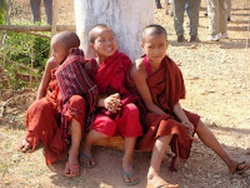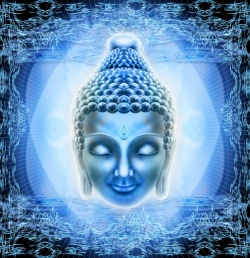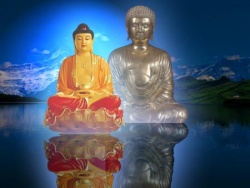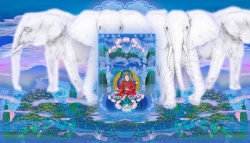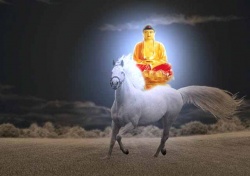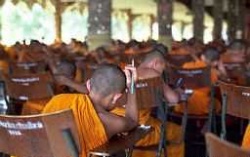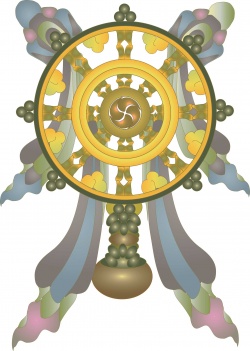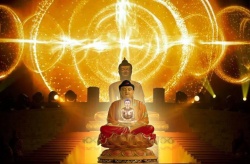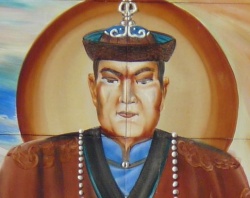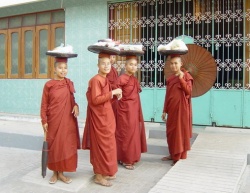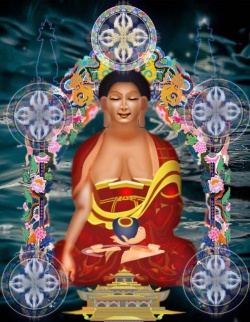Difference between revisions of "Buddhism in Russia"
| (4 intermediate revisions by 2 users not shown) | |||
| Line 1: | Line 1: | ||
| − | <nomobile>{{DisplayImages|3321|4472|4179|2077|4126|4213|2398|1666|4215|4149|4545|2906|4243| | + | <nomobile>{{DisplayImages|3321|4472|4179|2077|4126|4213|2398|1666|4215|4149|4545|2906|4243|}}</nomobile> |
| Line 11: | Line 11: | ||
Much later, another {{Wiki|mass}} of [[Buddhists]] joined [[Russia]] when the tsarist government annexed [[Tuva]], a region [[west]] of {{Wiki|Lake Baikal}} and [[north]] of [[Mongolia]]. | Much later, another {{Wiki|mass}} of [[Buddhists]] joined [[Russia]] when the tsarist government annexed [[Tuva]], a region [[west]] of {{Wiki|Lake Baikal}} and [[north]] of [[Mongolia]]. | ||
| − | Although the [[Buryats]], [[Kalmyks]], and Tuvans all shared a common [[religion]], [[Buddhism]] evolved {{Wiki|independently}} within each group. The results were {{Wiki|distinct}} national systems of [[monasteries]] ([[Buryat]] [[datsans]], {{Wiki|Kalmyk}} khuruls, and Tuvankhure) and separate national {{Wiki|ecclesiastical}} structures. | + | Although the [[Buryats]], [[Kalmyks]], and [[Tuvans]] all shared a common [[religion]], [[Buddhism]] evolved {{Wiki|independently}} within each group. The results were {{Wiki|distinct}} national systems of [[monasteries]] ([[Buryat]] [[datsans]], {{Wiki|Kalmyk}} [[khuruls]], and Tuvankhure) and separate national {{Wiki|ecclesiastical}} structures. |
[[Buddhism]] had been known among the [[western]] {{Wiki|Mongolian}} [[Oirat]] tribes of [[Derbets]] and [[Torguts]] since the thirteenth century, but it did not become widely practiced by them until the beginning of the seventeenth century. | [[Buddhism]] had been known among the [[western]] {{Wiki|Mongolian}} [[Oirat]] tribes of [[Derbets]] and [[Torguts]] since the thirteenth century, but it did not become widely practiced by them until the beginning of the seventeenth century. | ||
| Line 23: | Line 23: | ||
It was built before 1616 in the region of present-day [[Semipalatinsk]]. | It was built before 1616 in the region of present-day [[Semipalatinsk]]. | ||
| − | Others followed, including [[Ablain-kit]] (1656), [[Botoktukhan-kit]] (1670), [[Dzhalin-obo]], [[Ohirtukhan-kit]], and [[Tsagan-sume]]. | + | Others followed, [[including]] [[Ablain-kit]] (1656), [[Botoktukhan-kit]] (1670), [[Dzhalin-obo]], [[Ohirtukhan-kit]], and [[Tsagan-sume]]. |
In 1771, as a result of persecution by the tsarist government, the bulk of the [[Kalmyks]] fled back to {{Wiki|Dzungaria}} (in present-day [[China]]). | In 1771, as a result of persecution by the tsarist government, the bulk of the [[Kalmyks]] fled back to {{Wiki|Dzungaria}} (in present-day [[China]]). | ||
| Line 93: | Line 93: | ||
This growth was facilitated by the establishment of a system of uninterrupted [[Buddhist education]]. | This growth was facilitated by the establishment of a system of uninterrupted [[Buddhist education]]. | ||
| − | After the [[appearance]] in [[Buryatia]] of [[Buddhist]] [[faculties]] of tsannit ([[philosophy]]), completion of such a course of studies became obligatory for the {{Wiki|clergy}} of [[datsans]]. The base {{Wiki|curriculum}} lasted for fourteen years, beginning after two years of primary [[education]]. | + | After the [[appearance]] in [[Buryatia]] of [[Buddhist]] [[faculties]] of [[tsannit]] ([[philosophy]]), completion of such a course of studies became obligatory for the {{Wiki|clergy}} of [[datsans]]. The base {{Wiki|curriculum}} lasted for fourteen years, beginning after two years of primary [[education]]. |
It included the following themes: fundamental theories of [[knowledge]] and [[logic]] in the third and fourth years; | It included the following themes: fundamental theories of [[knowledge]] and [[logic]] in the third and fourth years; | ||
| Line 107: | Line 107: | ||
In [[Buryat]] [[tantric]] [[datsans]] after ten years one could receive the title of [[zhedrimba]], i.e., attain the first of two ranks of [[perfection]] on the scale of [[Vajrayana]]. | In [[Buryat]] [[tantric]] [[datsans]] after ten years one could receive the title of [[zhedrimba]], i.e., attain the first of two ranks of [[perfection]] on the scale of [[Vajrayana]]. | ||
| − | Ten more years after that were required to receive the rank of [[zogrimbawhich]] signified complete [[mastery]] of the techniques of [[meditative]] control of energies and channels. | + | Ten more years after that were required to receive the rank of [[zogrimbawhich]] signified complete [[mastery]] of the [[techniques]] of [[meditative]] control of energies and [[channels]]. |
This [[highest]] level of [[perfection]] was given the {{Wiki|honorary}} title of Dorzhezinba ([[Sanskrit]]: [[Vajradhara]]). | This [[highest]] level of [[perfection]] was given the {{Wiki|honorary}} title of Dorzhezinba ([[Sanskrit]]: [[Vajradhara]]). | ||
| Line 115: | Line 115: | ||
One of these [[traditions]] was [[Tibetan medicine]]. | One of these [[traditions]] was [[Tibetan medicine]]. | ||
| − | In 1869 in the [[Tsugol datsan]] the official [[teaching]] of Indo-Tibetan [[medicine]] began (it had been practiced informally since the eighteenth century). | + | In 1869 in the [[Tsugol datsan]] the official [[teaching]] of [[Indo-Tibetan]] [[medicine]] began (it had been practiced informally since the eighteenth century). |
| − | By the end of the nineteenth century it had [[attained]] such [[success]] that [[doctors]] of [[Tibetan medicine]] [[Tsul'tim (Aleksandr]]) [[Badmaev]] (d.1873) and his younger brother [[Zhamsaran]] ( | + | By the end of the nineteenth century it had [[attained]] such [[success]] that [[doctors]] of [[Tibetan medicine]] [[Tsul'tim (Aleksandr]]) [[Badmaev]] (d.1873) and his younger brother [[Zhamsaran]] (Petr) [[Badmaev]] (1810-1920) traveled to {{Wiki|St. Petersburg}} and treated famous [[people]] and even the {{Wiki|imperial}} [[family]]. |
| Line 134: | Line 134: | ||
The church's head, the [[Shadzhin-Lama]], or [[Lama]] of the {{Wiki|Kalmyk people}}, received his salary from the {{Wiki|Russian}} government. | The church's head, the [[Shadzhin-Lama]], or [[Lama]] of the {{Wiki|Kalmyk people}}, received his salary from the {{Wiki|Russian}} government. | ||
| − | The tsarist administration attempted to restrict the spread of [[Buddhism]] through its Regulation on the Administration of the {{Wiki|Kalmyk}} [[People]] of 1838, which limited the number of {{Wiki|clergy}} to 2,650 in 76 [[khuruls]] at a time when the real number of {{Wiki|clergy}} was 5,270 and the real number of khuruls was 105. | + | The tsarist administration attempted to restrict the spread of [[Buddhism]] through its Regulation on the Administration of the {{Wiki|Kalmyk}} [[People]] of 1838, which limited the number of {{Wiki|clergy}} to 2,650 in 76 [[khuruls]] at a time when the real number of {{Wiki|clergy}} was 5,270 and the real number of [[khuruls]] was 105. |
Nine years later the Regulation of 1847 reduced the legal limits to 1,656 {{Wiki|clergy}} and 67 [[khuruls]]. | Nine years later the Regulation of 1847 reduced the legal limits to 1,656 {{Wiki|clergy}} and 67 [[khuruls]]. | ||
| Line 144: | Line 144: | ||
In 1914 another [[Buddhist]] [[people]] joined [[Russia]]. | In 1914 another [[Buddhist]] [[people]] joined [[Russia]]. | ||
| − | The Tuvans were the only {{Wiki|Turkish}} [[people]] who confessed [[Buddhism]], and they became [[subjects]] of the {{Wiki|tsar}} when [[Russia]] annexed [[Tuva]] and made it a protectorate named [[Uriankhai]], after the fall of the [[Manchurian]] {{Wiki|dynasty}} in [[China]]. | + | The [[Tuvans]] were the only {{Wiki|Turkish}} [[people]] who confessed [[Buddhism]], and they became [[subjects]] of the {{Wiki|tsar}} when [[Russia]] annexed [[Tuva]] and made it a protectorate named [[Uriankhai]], after the fall of the [[Manchurian]] {{Wiki|dynasty}} in [[China]]. |
At the time of annexation there were already twenty-two [[Buddhist monasteries]] ([[khure]]) and about 4,000 [[lamas]] and [[khuvaraki]] in the [[Uriankhai]] province. About half of the [[lamas]] lived not in [[monasteries]] but as householders with families. | At the time of annexation there were already twenty-two [[Buddhist monasteries]] ([[khure]]) and about 4,000 [[lamas]] and [[khuvaraki]] in the [[Uriankhai]] province. About half of the [[lamas]] lived not in [[monasteries]] but as householders with families. | ||
| Line 182: | Line 182: | ||
The vortex of post-revolution {{Wiki|political}} struggle sucked in the [[Buddhist]] {{Wiki|church}}. | The vortex of post-revolution {{Wiki|political}} struggle sucked in the [[Buddhist]] {{Wiki|church}}. | ||
| − | [[Lamas]] participated in attempts to create a pan-Mongol {{Wiki|theocratic}} government, the [[Kizhinga]] [[lama]] [[Sandan Tsydenov]] established the so-called [Bulagat theocratic movement]], and the [[schism]] that had begun at the end of the nineteenth century between reform-minded (Renovationist) and conservative {{Wiki|clergy}} grew even sharper. | + | [[Lamas]] participated in attempts to create a pan-Mongol {{Wiki|theocratic}} government, the [[Kizhinga]] [[lama]] [[Sandan Tsydenov]] established the so-called [Bulagat {{Wiki|theocratic}} {{Wiki|movement}}]], and the [[schism]] that had begun at the end of the nineteenth century between reform-minded (Renovationist) and conservative {{Wiki|clergy}} grew even sharper. |
| − | The Renovationist party headed by A. [[Dorzhiev]] was prepared to cooperate with [[Soviet]] authorities for the sake of saving [[religion]], to seek parallels between the [[teachings of Buddha]] and Marx, and to eliminate the inequalities of property ownership among [[monks]]. | + | The Renovationist party headed by A. [[Dorzhiev]] was prepared to cooperate with [[Soviet]] authorities for the [[sake]] of saving [[religion]], to seek parallels between the [[teachings of Buddha]] and Marx, and to eliminate the inequalities of property ownership among [[monks]]. |
The conservatives wanted everything to remain as it was. | The conservatives wanted everything to remain as it was. | ||
| Line 233: | Line 233: | ||
Soon permission was given to open a second [[Buddhist temple]] – the [[Agin datsan]] in the [[Chita] region. Despite the strict control of the government, these two [[datsans]] preserved the [[Buddha's teaching]] over the all the long decades preceding the beginning of perestroika, or {{Wiki|political}} reforms. | Soon permission was given to open a second [[Buddhist temple]] – the [[Agin datsan]] in the [[Chita] region. Despite the strict control of the government, these two [[datsans]] preserved the [[Buddha's teaching]] over the all the long decades preceding the beginning of perestroika, or {{Wiki|political}} reforms. | ||
| − | After L.-N. Darmaev, from 1956 to 1963, the post of [[Bandido Khambo-Lama]] was occupied by [[Eshi Dorzhi Sharapov[[ (1885-1963), and after that by ppZhambal Gomboev[[ (1897-1983). | + | After [[L.-N. Darmaev]], from 1956 to 1963, the post of [[Bandido Khambo-Lama]] was occupied by [[Eshi Dorzhi Sharapov[[ (1885-1963), and after that by ppZhambal Gomboev[[ (1897-1983). |
| Line 242: | Line 242: | ||
Some of the [[lamas]] started to take on [[disciples]] informally, outside the [[traditional]] [[Buddhist]] structures. The most famous such group formed around the [[Buryat]] [[lama]] [[B. Dandaron]]. | Some of the [[lamas]] started to take on [[disciples]] informally, outside the [[traditional]] [[Buddhist]] structures. The most famous such group formed around the [[Buryat]] [[lama]] [[B. Dandaron]]. | ||
| − | In 1972 [[Dandaron]] was arrested for organizing a [[Buddhist]] [[sect]] and two years later perished in the [[Soviet]] Gulag. | + | In 1972 [[Dandaron]] was arrested for organizing a [[Buddhist]] [[sect]] and two years later perished in the [[Soviet]] [[Gulag]]. |
The government began to make use of legal [[Buddhism]] for the service of its {{Wiki|political}} needs in the [[East]] and to demonstrate to the nations of {{Wiki|Asia}} freedom of {{Wiki|conscience}} in the {{Wiki|Soviet Union}}. | The government began to make use of legal [[Buddhism]] for the service of its {{Wiki|political}} needs in the [[East]] and to demonstrate to the nations of {{Wiki|Asia}} freedom of {{Wiki|conscience}} in the {{Wiki|Soviet Union}}. | ||
| Line 260: | Line 260: | ||
| − | Today more than 200 [[Buddhist]] communities are active in {{Wiki|Russian}} territory. Besides the [[Tibetan Buddhism]] native to the [[Kalmyks]], [[Buryats]], and Tuvans, other branches of the [[Dharma]] are now flourishing as well: [[Theravada]], [[Korean Son]] [[Buddhism]], and the [[Japanese]] [[tradition]] of theLotus [[Sutra]]. | + | Today more than 200 [[Buddhist]] communities are active in {{Wiki|Russian}} territory. Besides the [[Tibetan Buddhism]] native to the [[Kalmyks]], [[Buryats]], and [[Tuvans]], other branches of the [[Dharma]] are now flourishing as well: [[Theravada]], [[Korean Son]] [[Buddhism]], and the [[Japanese]] [[tradition]] of theLotus [[Sutra]]. |
The [[Tibetan tradition]] itself is not limited, as it was in the pre-war period, to a monopoly of the [[Gelug school]]. | The [[Tibetan tradition]] itself is not limited, as it was in the pre-war period, to a monopoly of the [[Gelug school]]. | ||
| − | By the end of the twentieth century in [[Russia]] all the other [[Tibetan]] schools had appeared: [[Nyingma]], Kag'iu, [[Sakya]], and [[Dzogchen]] as [[taught]] by [[Namkhai Norbu Rinpoche]] (b.1938), which unites [[Buddhist]] and [[Bon]] versions of this [[doctrine]]. The majority of [[Buddhist]] communities are united by a centralized [[organization]]: the old TsDUB, which was renamed The [[Buddhist]] [[Traditional]] [[Sangha]] of [[Russia]] in 1996. | + | By the end of the twentieth century in [[Russia]] all the other [[Tibetan]] schools had appeared: [[Nyingma]], [[Kag'iu]], [[Sakya]], and [[Dzogchen]] as [[taught]] by [[Namkhai Norbu Rinpoche]] (b.1938), which unites [[Buddhist]] and [[Bon]] versions of this [[doctrine]]. The majority of [[Buddhist]] communities are united by a centralized [[organization]]: the old TsDUB, which was renamed The [[Buddhist]] [[Traditional]] [[Sangha]] of [[Russia]] in 1996. |
Besides the [[Buryat]] communities, several organizations from the {{Wiki|European}} part of the {{Wiki|Russian Federation}} joined this [[organization]]. | Besides the [[Buryat]] communities, several organizations from the {{Wiki|European}} part of the {{Wiki|Russian Federation}} joined this [[organization]]. | ||
| Line 279: | Line 279: | ||
Before 1990 the [[Buddhists]] of [[Russia]] generally had no opportunities to publish their [[own]] {{Wiki|literature}}. | Before 1990 the [[Buddhists]] of [[Russia]] generally had no opportunities to publish their [[own]] {{Wiki|literature}}. | ||
| − | Since 1991 the first [[Buddhist]] [[books]] began to be published, as well as a number of [[Buddhist]] journals, including [[Buddhism]] (just two issues have appeared), [[Narthang]] Bulletin (renamed [[Buddhism]] of [[Russia]] in 1995), [[Garuda]], Mir Kag'iu (now Buddhism.ru) and others. By 2003 approximately fifty [[Buddhist]] internet sites were functioning; nowadays there are many more. | + | Since 1991 the first [[Buddhist]] [[books]] began to be published, as well as a number of [[Buddhist]] journals, [[including]] [[Buddhism]] (just two issues have appeared), [[Narthang]] Bulletin (renamed [[Buddhism]] of [[Russia]] in 1995), [[Garuda]], [[Mir Kag'iu]] (now Buddhism.ru) and others. By 2003 approximately fifty [[Buddhist]] internet sites were functioning; nowadays there are many more. |
| Line 286: | Line 286: | ||
{{Wiki|Resurrection}} of the standard twenty-year course of studies of [[Tibetan Buddhist]] [[education]] remains far in the {{Wiki|future}}, and the country still [[suffers]] a severe lack of educated [[Buddhist]] {{Wiki|clergy}}. | {{Wiki|Resurrection}} of the standard twenty-year course of studies of [[Tibetan Buddhist]] [[education]] remains far in the {{Wiki|future}}, and the country still [[suffers]] a severe lack of educated [[Buddhist]] {{Wiki|clergy}}. | ||
| − | The situation will not change until the {{Wiki|Kalmyk}}, [[Buryat]], and Tuvan youths who have traveled to [[India]] to study in [[Tibetan monasteries]] return (as a result of the {{Wiki|Chinese}} takeover of [[Tibet]] in 1959, there was a {{Wiki|mass}} exodus of [[Buddhist monks]] and many of them established new [[monasteries]] in [[India]]). | + | The situation will not change until the {{Wiki|Kalmyk}}, [[Buryat]], and [[Tuvan]] youths who have traveled to [[India]] to study in [[Tibetan monasteries]] return (as a result of the {{Wiki|Chinese}} takeover of [[Tibet]] in 1959, there was a {{Wiki|mass}} exodus of [[Buddhist monks]] and many of them established new [[monasteries]] in [[India]]). |
| − | In the meantime, in all the [[traditional]] [[Buddhist]] regions, and also in {{Wiki|Moscow}} and Petersburg, the [[Dharma]] is [[taught]] primarily by [[Tibetan]] [[monks]], some of whom live in [[Russia]] on a [[permanent]] basis, while others come especially for the {{Wiki|purpose}} of preaching and conferring [[empowerments]]. | + | In the meantime, in all the [[traditional]] [[Buddhist]] regions, and also in {{Wiki|Moscow}} and [[Petersburg]], the [[Dharma]] is [[taught]] primarily by [[Tibetan]] [[monks]], some of whom live in [[Russia]] on a [[permanent]] basis, while others come especially for the {{Wiki|purpose}} of preaching and conferring [[empowerments]]. |
| + | {{E}} | ||
| + | [[Category:Russia]] | ||
| + | [[Category:Buryatia]] | ||
Latest revision as of 13:49, 28 November 2023
The Tibetan form of Buddhism first spread to Russia in the seventeenth and eighteenth centuries, when the nomadic Mongol tribes of Oirats (present-day Kalmyks) and Buryats migrated to the lower reaches of the Volga and to the east of Lake Baikal.
Much later, another mass of Buddhists joined Russia when the tsarist government annexed Tuva, a region west of Lake Baikal and north of Mongolia.
Although the Buryats, Kalmyks, and Tuvans all shared a common religion, Buddhism evolved independently within each group. The results were distinct national systems of monasteries (Buryat datsans, Kalmyk khuruls, and Tuvankhure) and separate national ecclesiastical structures.
Buddhism had been known among the western Mongolian Oirat tribes of Derbets and Torguts since the thirteenth century, but it did not become widely practiced by them until the beginning of the seventeenth century.
During the second half of that century these tribes migrated to the region of the lower Volga and Don, created the Kalmyk khanate, and made Buddhism its official religion.
The Oirats arrived on Russian territory more than 400 years ago with nomadic monasteries (khuruls) consisting of three or more tents.
Sedentary monasteries quickly began to appear. One of the earliest was Darkhan-Dorzhin-kit (Russian СемьПалат or seven chambers).
It was built before 1616 in the region of present-day Semipalatinsk.
Others followed, including Ablain-kit (1656), Botoktukhan-kit (1670), Dzhalin-obo, Ohirtukhan-kit, and Tsagan-sume.
In 1771, as a result of persecution by the tsarist government, the bulk of the Kalmyks fled back to Dzungaria (in present-day China).
The 13,000 families of Kalmyks who remained in Russia were resettled along the Ural, Terek, and Kuma rivers.
Not counting the khuruls that migrated out of Russia in 1771 with the mass of the Kalmyk people, by the end of the eighteenth century fourteen Buddhist monasteries remained among the Kalmyks.
Religious leaders among the Kalmyks were called lamas, while the remaining religious individuals – monks and those studying to become lamas – were khuvaraki (singular khuvarak).
After the out-migration of 1771 the Buddhist church was decentralized and each region (ulus) chose its own head Lama.
There were three ranks of khuvaraki: mandzhi, getsul', and geliung.
Since the beginning of the eighteenth century advancement through these ranks was controlled by a system of monastic education:
a young mandzhi would study for five years to reach the first monastic rank of 'getsul', after which eight more years of education would be required to reach the rank of 'geliung'.
Finally there would be five to seven more years of study, generally completed by the age of thirty.
Apparently, among the Kalmyks we find a legal system requiring universal compulsory education for boys for the first time in world history. This is prescribed in section seven of the second chapter of the law code promulgated in the reign of khan Dondok-Dashi (1741-1753):
If any of the sons of the noble people shall not be taught reading and writing in todo ueeg [the Oirat alphabet], then the father shall pay a three-year-old horse as a fine and the son shall be given to a teacher for instruction.
The fine for the same offense from a person known to society: a three-year-old sheep. From a commoner: fifteen kopecks [1], and the son is given to instruction just as in the above situation. If he does not educate his son before age fifteen, he will be punished for this.
Buddhism penetrated the area east of Lake Baikal at around the same time.
The first reports of Buddhist beliefs among the Buryats come from Moscow in 1647 (by the Cossack captain K. Moskvitin).
By 1741 eleven lama temples and 150 Tibetan and Mongolian monks expelled from Gomang Datsan of Tibetan Drepung Monastery were registered in Transbaikalia.
Agvan Puntsok, a Tibetan from Chone, was the head lama.
Historians frequently cite a decree of Empress Elizabeth from 1741 as officially recognizing Buddhism in Russia, but so far we have been unable to discover evidence of this decree among the collections of state documents.
The first Buryat temples (sume) were composed of yurts and traveled along with their nomadic parishioners.
Not until approximately 1753-58 did the first wooden Buddhist temple begin to be built – the Tsongol datsan (later called Khilgantuivskiy).
The head of the monastery was Damba Darzha Zayaev (1711-1777), an aide and disciple of Agvan Puntsok (2).
The wooden buildings of Gusino-ozero (Goose Lake) datsan were probably built a little later. It was founded by Lubsan Zhimba Akhaldaev, who had been educated in Tibet.
A rivalry between these two Buryat monastic centers started and continued up to the beginning of the nineteenth century, at which time the tsarist administration recognized the priority of the Goose Lake datsan.
The head of that monastery was given the title Bandido-Khambo-lama of all Buryat datsans.
The title consists of a Mongolized pronunciation of Sanskrit - pandita meaning learned and Tibetan khenpo-lama meaning head lama.
Before that time, both leaders of the rival groups carried the title Bandido-Khambo-lama.
By 1846 144 buildings in 34 monasteries had been built in Buryatia, and the number of clergy was increasing rapidly. While there were just 150 lamas (3) in 1741, by 1796 there were 700, and in 1831 there were 4,637.
The Russian government tried to put a stop to the development of Buddhism among the Buryats as part of its efforts to facilitate the Christianization of the region.
In 1853 it forbade the building of new datsans other than the already existing 34 in a law titled Regulation Concerning Lamaist Clergy in Eastern Siberia. It also attempted to limit the growth of the number of lamas by stipulating that only one lama per 200 parishioners would be tax-free.
This would have resulted in a limit of 285 established lamas, and the remaining thousands of clergy would be taxed just like ordinary peasants.
As a practical matter, however, the 1853 law was not actively enforced because the government had plans for expansion in East Asia and was afraid of stirring up too much dissatisfaction among the population of this key region.
And so Buryat Buddhism continued its rapid growth.
This growth was facilitated by the establishment of a system of uninterrupted Buddhist education.
After the appearance in Buryatia of Buddhist faculties of tsannit (philosophy), completion of such a course of studies became obligatory for the clergy of datsans. The base curriculum lasted for fourteen years, beginning after two years of primary education.
It included the following themes: fundamental theories of knowledge and logic in the third and fourth years;
the system of Buddhist paths of development (paramita) in the fifth through ninth years;
in-depth study of the teaching of emptiness (madhyamaka) in the twelfth and thirteenth years; and an introduction to monastic discipline (vinaya) in the fourteenth year.
The fourteenth year was not the end, for a complete course of study in monastic discipline would take eight years. Those who completed the entire program took exams leading to the rank of gabzha, equivalent to a doctorate.
In addition, a person who completed the tsannit program could go on to study in the tantric program.
In Buryat tantric datsans after ten years one could receive the title of zhedrimba, i.e., attain the first of two ranks of perfection on the scale of Vajrayana.
Ten more years after that were required to receive the rank of zogrimbawhich signified complete mastery of the techniques of meditative control of energies and channels.
This highest level of perfection was given the honorary title of Dorzhezinba (Sanskrit: Vajradhara).
The Buryats expended a tremendous amount of effort and material resources in order to import a mass of treasured literature from Tibet, China, and Mongolia, and to adopt many living traditions from Tibetan Buddhism.
One of these traditions was Tibetan medicine.
In 1869 in the Tsugol datsan the official teaching of Indo-Tibetan medicine began (it had been practiced informally since the eighteenth century).
By the end of the nineteenth century it had attained such success that doctors of Tibetan medicine Tsul'tim (Aleksandr) Badmaev (d.1873) and his younger brother Zhamsaran (Petr) Badmaev (1810-1920) traveled to St. Petersburg and treated famous people and even the imperial family.
In 1878 in the Aginsk datsan the Kalachakra school was founded, marking the final stage in the building of a system of higher education following the Tibetan model.
Book printing and publishing developed quickly.
In 1887 there were already twenty-nine publishing houses, which together managed to publish around 2,000 titles in the Tibetan and Mongol languages until their demise under the Communists in the 1930s.
In Kalmykia, located far closer to the center of Russia than Buryatia, the tsarist government took a much more active role in trying to prevent the spread and growth of Buddhism.
At the end of the eighteenth century, after the independent Kalmyk khanate was swallowed up and the out-migration of most Kalmyks to Dzungaria, the Kalmyk steppe was transformed into one of the administrative regions of Russia.
It was placed under the authority of the military governor of Astrakhan, and its Buddhist church was also completely subjected to government control.
The church's head, the Shadzhin-Lama, or Lama of the Kalmyk people, received his salary from the Russian government.
The tsarist administration attempted to restrict the spread of Buddhism through its Regulation on the Administration of the Kalmyk People of 1838, which limited the number of clergy to 2,650 in 76 khuruls at a time when the real number of clergy was 5,270 and the real number of khuruls was 105.
Nine years later the Regulation of 1847 reduced the legal limits to 1,656 clergy and 67 khuruls.
Nevertheless, the first choira – a school for education of Kalmyk clergy – was opened in 1907, and in 1908 the second such school was opened. After 1910 the Baksha-Lama of the Don Kalmyks, Mynko Barmanzhinov, opened a third choira.
Thus the position of the Buddhist church was well established right up to the time of the Revolution.
In 1914 another Buddhist people joined Russia.
The Tuvans were the only Turkish people who confessed Buddhism, and they became subjects of the tsar when Russia annexed Tuva and made it a protectorate named Uriankhai, after the fall of the Manchurian dynasty in China.
At the time of annexation there were already twenty-two Buddhist monasteries (khure) and about 4,000 lamas and khuvaraki in the Uriankhai province. About half of the lamas lived not in monasteries but as householders with families.
Sedentary (as opposed to nomadic) Buddhist monasteries began to be built in Tuva in the 1770s.
The greatest of these at the turn of the century were Erzinsk (founded 1772), Samgaltaisk (1770), Oiunnarsk (1773), Upper-Chadan, and Lower-Chadan (1873).
The Buddhist clergy of Tuva was led by the head of the Chadan khure, who carried the title Kamba-Lama and was himself subject to the Buddhist church of Mongolia.
Many khure had schools in which children were given an elementary religious education. Tuvans usually sought higher theological education in Mongolia.
By the beginning of the twentieth century Russia was interested in strengthening its ties in the East, and it especially wanted to establish direct contact with the theocratic governments of Mongolia and Tibet.
Toward this end, a Buddhist temple was built in St. Petersburg.
The construction and operation of this temple was overseen by Agwan Dorzhiev (1853-1938), the outstanding Buryat lama who was nominated as a debate-partner to a young 13th Dalai Lama, gained his confidence and acted as representative of Tibet in Russia.
Working closely with him was D.D. Itigelov (1853-1924), who occupied the post of Bandido Khambo Lama from 1911 through 1918.
Itigelov's body was exhumed in 2002 in accordance with his will and found to be incorrupt, which was considered by local Buddhists to be evidence that he had attained the highest level of holiness.
Educated Kalmyk and Buryat lamas began to cooperate with Russian orientalists, and the resulting Buddhological school began to take a leading position in worldwide scholarship.
It was led by F. I. Shcherbatskiy (1866-1942), who in 1905 traveled to Mongolia to meet the thirteenth Dalai Lama.
At this time Buddhism also began to exert an influence on Russian creative intelligentsia: Bal'mont translated into the Russian language Ashvaghosha's Buddhacarita, and the Roerih family traveled to Tibet.
Certain mystical ideas, extracted from Buddhism, penetrated later even into the OGPU (predecessor of the KGB).
A circle for the study of the Kalachakra, one of the most treasured doctrines of Vajrayana Buddhism, was established there with the help of G. I. Bokii, head of the Special Section (department of cryptography).
At the Institute of Oriental Studies in Leningrad in 1928 a new Institute of Buddhist Culture was created, but it did not survive the Stalinist terror.
In 1937 almost all of its scholars were arrested.
The vortex of post-revolution political struggle sucked in the Buddhist church.
Lamas participated in attempts to create a pan-Mongol theocratic government, the Kizhinga lama Sandan Tsydenov established the so-called [Bulagat theocratic movement]], and the schism that had begun at the end of the nineteenth century between reform-minded (Renovationist) and conservative clergy grew even sharper.
The Renovationist party headed by A. Dorzhiev was prepared to cooperate with Soviet authorities for the sake of saving religion, to seek parallels between the teachings of Buddha and Marx, and to eliminate the inequalities of property ownership among monks.
The conservatives wanted everything to remain as it was.
At the beginning of the 1930s, as the period of 'collectivization' began, it became clear that the real question was whether the Buddhist clergy could survive at all.
Even the Renovationist party's program (see my previous article in this series) was set aside in the face of new tragedies. Lamas were stripped of the right to own land, and taxes on them were increased so much that for many it was impossible to stay in the monasteries.
Arrests and pogroms began, during which works of art and literature were mercilessly destroyed.
By 1935 approximately one third of Buryat datsans were empty because all of the clergy had either fled or been imprisoned or executed.
In 1936 the remaining ones were closed and the lamas were arrested as enemies of the people or Japanese spies.
An analogous process took place in Kalmykia and the formally independent (since 1921) Tanna-Tuva.
In Kalmykia, over the period 1917 to 1937, 79 khuruls were liquidated.
The cancellation in 1943 of Kalmyk autonomy and the genocide-like resettlement of the Kalmyk people to Siberia left no one willing or able to stop the destruction of temples and Buddhism in Kalmykia.
In Tanna-Tuva, at first the religion was untouched, and in 1928 the Malyi Khural (parliament) even passed a law proclaiming Buddhism the state religion.
This apparently provoked the destruction of religion that began in 1929 and intensified in 1930 by Resolution II of the Plenum of the Central Committee and TsKK ARP On the Lamaist Question.
According to eyewitnesses, they started to come for the lamas systematically: at first they took the upper levels of the clergy, then the next level down, and so on until all had been removed.
In Tuva, as in Kalmykia, all of the temples were burned to the ground.
And if among the Kalmyks nevertheless there remained one stone building – the stone Khosheutov khurul of the Tiumen princes – in Tuva there remained only remains of the one-meter-thick walls of the Chadan khure.
The very small portion of Buddhist manuscripts, sculpture, and tapestries which were saved ended up in Moscow and Leningrad museums, making them the richest collections in the world of Buddhist art.
At the end of the Second World War, Stalin softened his attitude toward religion, and this was reflected in the government's relations with Buddhism.
Taking into account the patriotic activities of Buddhists during the Great Fatherland War, the government gave the Buddhists of Buryatia permission to rebuild one small monastery.
A congress of leading Buddhists from the Buryat-Mongol Autonomous Republic took place May 21-23, 1946 in Ulan-Ude, organized by a group of lamas and believers headed by former monks A. Galsanov and L.-M. Darmaev.
It established a Law of Spiritual Administration of Buddhists and a Regulation for Buddhist Clergy of the USSR in which lamas were obligated to honor the Fatherland of workers on an equal level with their holy Buddhist faith and in every way promote its strengthening and flourishing.
The governing organ of the Buddhist church was the Central Spiritual Board of Buddhists of the USSR ('TsDUB'), headed by a Chairman who was given the old title 'Bandido Khambo-Lama'.
The residence of TsDUB was the new temple Khambin sume (now the Ivolginsky datsan), constructed in a swamp area some thirty kilometers from Ulan-Ude. The first Bandido Khambo-Lama of the new era was Lobsan-Nima Darmaev (1890-1960).
Soon permission was given to open a second Buddhist temple – the Agin datsan in the [[Chita] region. Despite the strict control of the government, these two datsans preserved the Buddha's teaching over the all the long decades preceding the beginning of perestroika, or political reforms.
After L.-N. Darmaev, from 1956 to 1963, the post of Bandido Khambo-Lama was occupied by [[Eshi Dorzhi Sharapov[[ (1885-1963), and after that by ppZhambal Gomboev[[ (1897-1983).
Besides these centers, for which all of twenty or so clergy were permitted, throughout the Buddhist lands about a hundred of former lamas were illegally active, having been released from camps.
They carried out religious ceremonies for fellow villagers and practiced Tibetan medicine. The KGB carefully watched them but did not interfere, limiting itself to warnings.
Some of the lamas started to take on disciples informally, outside the traditional Buddhist structures. The most famous such group formed around the Buryat lama B. Dandaron.
In 1972 Dandaron was arrested for organizing a Buddhist sect and two years later perished in the Soviet Gulag.
The government began to make use of legal Buddhism for the service of its political needs in the East and to demonstrate to the nations of Asia freedom of conscience in the Soviet Union.
For this purpose in 1956 the TsDUB SSSR was entered into the International Brotherhood of Buddhists, and in 1969 a new international organization was created, the so-called Asiatic Buddhist Conference for Peace.
This was composed of Buddhist countries loyal to the Soviet Union or dependent on it.
In the 1970s a Buddhist College of higher education was established and began to prepare new cadres for Mongolia and Buryatia to replace the outgoing generation, by means of a short five-year course of studies.
With the start of perestroika, which heralded the reforms that ended the Soviet Union, Buddhism's renaissance and growth throughout the country began in earnest.
In 1988 and 1989, the first Buddhist communities were registered in Tuva, Kalmykia, and Leningrad.
In 1991 for the first time the 14th Dalai Lama openly visited Moscow and Buddhist regions of the country, giving a powerful impulse to the Buddhist renaissance. His earlier visits of 1979 and 1981 were not advertised by press.
Today more than 200 Buddhist communities are active in Russian territory. Besides the Tibetan Buddhism native to the Kalmyks, Buryats, and Tuvans, other branches of the Dharma are now flourishing as well: Theravada, Korean Son Buddhism, and the Japanese tradition of theLotus Sutra.
The Tibetan tradition itself is not limited, as it was in the pre-war period, to a monopoly of the Gelug school.
By the end of the twentieth century in Russia all the other Tibetan schools had appeared: Nyingma, Kag'iu, Sakya, and Dzogchen as taught by Namkhai Norbu Rinpoche (b.1938), which unites Buddhist and Bon versions of this doctrine. The majority of Buddhist communities are united by a centralized organization: the old TsDUB, which was renamed The Buddhist Traditional Sangha of Russia in 1996.
Besides the Buryat communities, several organizations from the European part of the Russian Federation joined this organization.
Since 1991 the Union of Buddhists of Kalmykia has been active there, led by Telo Rinpoche – i.e., a lama reincarnated from the great Indian yogi Tilopa (who is currently the only Rinpoche native of the Russian Federation).
In all three Buddhist republics the renaissance of Buddhism is seen as a sign of the strength of indigenous national non-Russified culture and accordingly is supported by the state.
According to the 1997 Russian Federation law on religion, On Freedom of Conscience and Religious Associations, Buddhism is counted as one of the four 'traditional religions of the Russian Federation' other than Orthodox Christianity (Judaism and Islam are the other two).
Before 1990 the Buddhists of Russia generally had no opportunities to publish their own literature.
Since 1991 the first Buddhist books began to be published, as well as a number of Buddhist journals, including Buddhism (just two issues have appeared), Narthang Bulletin (renamed Buddhism of Russia in 1995), Garuda, Mir Kag'iu (now Buddhism.ru) and others. By 2003 approximately fifty Buddhist internet sites were functioning; nowadays there are many more.
The problem of Buddhist education, however, has yet to be resolved. Although in Buryatia and Kalmykia institutions of higher Buddhist education have been established, they do not have enough financial resources or teaching staff.
Resurrection of the standard twenty-year course of studies of Tibetan Buddhist education remains far in the future, and the country still suffers a severe lack of educated Buddhist clergy.
The situation will not change until the Kalmyk, Buryat, and Tuvan youths who have traveled to India to study in Tibetan monasteries return (as a result of the Chinese takeover of Tibet in 1959, there was a mass exodus of Buddhist monks and many of them established new monasteries in India).
In the meantime, in all the traditional Buddhist regions, and also in Moscow and Petersburg, the Dharma is taught primarily by Tibetan monks, some of whom live in Russia on a permanent basis, while others come especially for the purpose of preaching and conferring empowerments.
